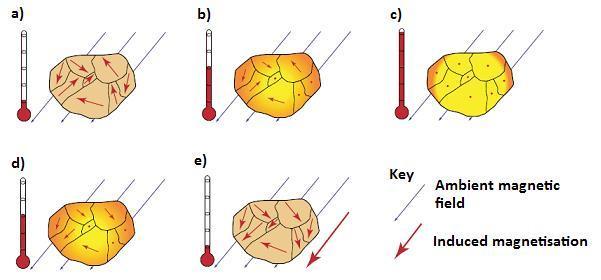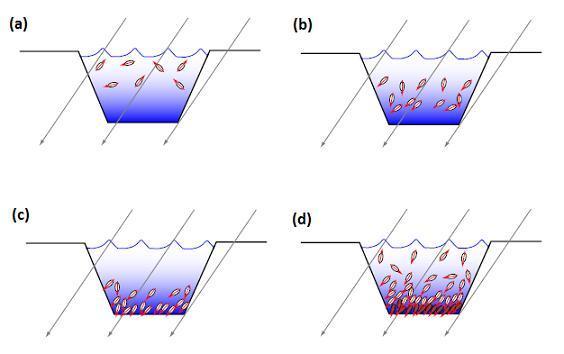What does archaeomagnetism date?
A material must contain magnetised particles of the right type and in sufficient quantities for a material to record the Earth's magnetic field. This includes most materials of geological origin, such as rocks and clay. There are two principal mechanisms by which the magnetic field is recorded: heat and deposition from a liquid (water lain deposits). Each of these mechanisms will be summarised in this section, as well as a reminder of the key information that needs to be taken into account when selecting a deposit for archaeomagnetic dating.
Heat
When magnetic minerals are heated (usually above approximately 400°C), the magnetic particles are free to align with magnetic north. As the material cools the magnetic field recorded within the material is fixed, thereby locking in a record of the location of magnetic north at that time. A material that obtains a record of the Earth's magnetic field through the application of heat is said to hold a thermo-remanent magnetisation (TRM) signal. The dated event is the last time the feature was heated and cooled over approximately 400°C.
If the material is heated, but the temperature does not exceed approximately 400°C, some magnetic particles will realign with the Earth's magnetic field but the more stable particles will retain their original position. This will results in a 'mixed' signal where two different positions of the Earth's magnetic field are recorded.
The types of features that record a TRM signal include hearths, kilns, ovens and furnaces.
Image description:
- (a) to (c) shows how the process of heating a sample up to, and above the Curie temperature causes the magnetic particles to demagnetise until there is no net magnetisation.
- As the material is cooled back through the Curie temperature, the magnetic particles remagnetise in a direction that is close to the prevailing magnetic field, as shown in (d) and (e), resulting in a net magnetisation within the sample.

Image copyright Paul Linford, English Heritage.
Water-Iain deposits
When a magnetic particle is suspended in water with a slow rate of flow, it is free to align with magnetic north and is referred to as depositional remanent magnetisation (DRM). As the particles settle out of the water they are deposited in layers; the weight of the sediment accumulating on top squeezes the water out of the material so that the magnetic particles are no longer free to move. This process locks in the orientation of the magnetic particles within the sediment and is the basis of the DRM signal. The types of deposits that record a DRM signal includes sediments found in lakes, ponds, within ditches and pits. Suitable deposits will be found within these sorts of locations as stratified layers of silty clay.
Image description:
- (a) to (c) shows how the sediment particles fall through the water, they become aligned with the Earth's magnetic field, settling on the bed of the body of water.
- The weight of the sediment accumulating on top locks the particles in place, as shown in (d), leaving a layer of material magnetised in the direction of the Earth's magnetic field.

Image copyright Paul Linford, English Heritage.
It is important to stress that archaeomagnetism provides a date for the last time a feature was cooled, or the last time the magnetic particles were deposited. For example, if a hearth is reused and heated above approximately 400°C, the previous record of the magnetic field will be erased and the new field recorded. Lower temperature reheating may also be detectable in some situations. With sediments retaining a depositional remanence, if the water table in an area changes, magnetic particles can become re-suspended and would therefore be free to move and realign with the Earth's magnetic field once again.
Most dating applications use the direction of the magnetic field to provide a date. The material must therefore remain in the same position as it was when it was fired or deposited. This restricts the contexts that can be dated to in situ features, such as hearths, kilns, moats, ditches etc.
The Earth's magnetic field also changes in terms of the strength/intensity of the field over time and can also be used to assign a date to a feature. It has the advantage over using directional information that the sampled materials do not need to be in situ, and so can include objects of fired clay, such as pottery, bricks, and tiles. However the measurement process is more complex and not commercially viable at present in the UK. Work is being carried out at the University of Liverpool to develop the secular variation curve for the changes in intensity of the magnetic field over time in the UK, and so this may be available in the future (http://www.liv.ac.uk/earth/geomagnetism/research.htm).
